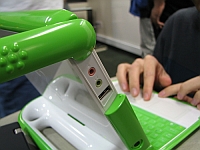In the implementation cost follow-up to the $970 price tag post, José Antonio Meira da Rocha left a very interesting comment about the three-way computer race in Brazil:
Man does not live by bread alone.Here is the Google Translation of the spreadsheet into English and the exchange rate is 1 USD = 2.15 Brazilian reais.This spreadsheet (in Portuguese, costs in "Real" currency) shows that digital inclusion of ALL childrens in Brazil will costs just a 50 grams bread a day per children.
Ancillary, shows that OLPC project will costs TEN TIMES LESS than desktops laboratories, in using hours.
Professor Meira da Rocha calculates $235.60USD per child/laptop over 5 years for One Laptop Per Brazilian Child. The differences in our approaches seem to be the following:
- Servers, setup, and power costs are all split out and calculated, using local information. The total comes close to the Libyan MOU number of $208/laptop, which makes sense. It does not include the "a team of technical advisers to help set up the system, satellite internet service and other infrastructure" mentioned in the NYT article, however.
- 20% maintenance costs, where I use only 5% - yes, I don't always give the highest possible estimate!
- Prof. Meira da Rocha also calculates a one-time transport cost (amortized over the 5 year lifespan), which in my analysis was left out, as it was partly included in the training project costs I referenced and partly rolled in to hidden costs absorbed by the Ministry of Education and their schools
- Internet in Brazil, at least in urban areas, much, much cheaper than the average. Rural areas will have to work using very extended meshes, WiMax, or satellite connections. Professor Meira da Rocha passed along this article about Parintins, Brasil, a very remote but very connected city. Also, this is cable modem Internet, so can reasonably be divided up among a much larger population. Prof. Meira da Rocha calculates this as one cable connection per school, divided among 331 students and professors/school, instead of dividing one dialup among 10 students.
This dramatically lowers the cost of connection from my estimate of $541/5yrs/student to about $10. This is fantastic news for urban areas with reasonably-priced high-speed Internet, but doesn't change the challenged faced by remote rural areas if the satellite Internet connection falls through.
- Prof. Meira da Rocha doesn't factor in training costs, which will factor in to most government implementations.
But the real problem starts when a school buys 50 or 100 cheap computers and sets up a network. Will the kids "learn learning" and teach the teachers? Do the computers even get used inside the classroom? Could they be stolen for the inevitable eBay sales? Or do they just sit in the principal's office gathering dust? Will school attendance increase? What about literacy and numeracy rates?
In essence, as with any technology implementation, it's not about the hardware, or its cost. The real success factors, the real costs and rewards are social, human, and according to Nicholas Negroponte incalculable by quantitative tests. And all are predicated on a solid implementation plan.




Excellent info about digital divide!!!
Who need see formulas can access the spreadsheet by link: http://spreadsheets.google.com/ccc?key=pH0vKjJkMrh1idN9DYPEAeg